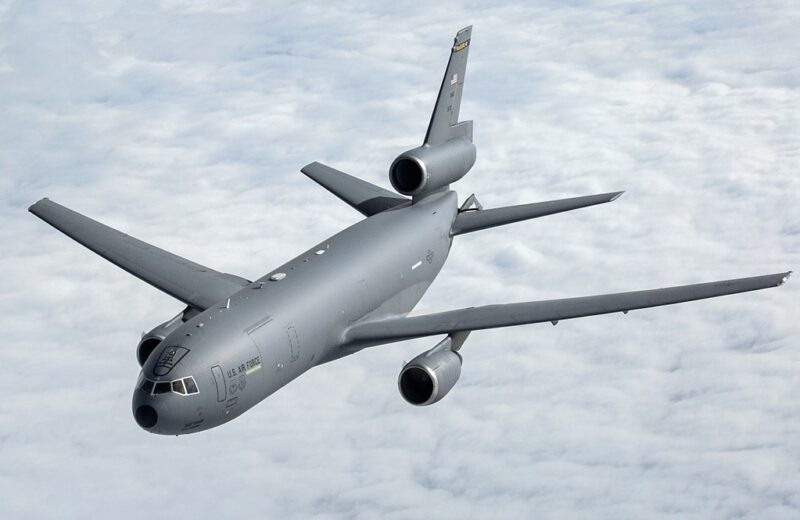The Boeing KC-46A Pegasus is an Advanced Midair Refueling Tanker Transport

Boeing’s cutting-edge tanker the KC-46A Pegasus, designed to seamlessly refuel aircraft in midair, is currently in service with the US Air Force, but it has faced production challenges since 2011. Get an exclusive insight into the USAF Pegasus program. The tanker transport jet was showcased at the prestigious Paris Airshow in June 2023.
As a leading global defense manufacturer, Boeing is renowned for delivering state-of-the-art military aircraft to the US armed forces and allied nations. With the Department of Defense being its largest federal customer, Boeing has secured numerous multi-billion dollar contracts for an extensive range of military assets, spanning from fighter jets and tankers to combat helicopters and freighters.
While Boeing’s defense division primarily focuses on military applications, it leverages its expertise in commercial planes to enhance production efficiency. Among its most notable creations is the KC-46A Pegasus aerial refueling tanker, derived from the Boeing 767 widebody airliner.

The KC-46A Pegasus, introduced in 2011 and delivered to the US Air Force in 2019, represents Boeing’s latest air refueler. With over 130 orders worldwide, including a recent $2.3 billion contract with the USAF for 15 additional tankers, this multi-mission jet is set to replace the aging KC-10 and KC-135 tankers—some of which date back to the Cold War era.
The USAF highlights the KC-46A’s superiority, citing its enhanced refueling, cargo, and aeromedical evacuation capabilities compared to the KC-135. However, the tanker has faced challenges due to flawed vision systems.

Boeing showcased the Pegasus aircraft at the Paris Airshow in June 2023, offering industry insiders the opportunity to explore its features and engage with KC-46A crew members. Gain a comprehensive understanding of this groundbreaking program by delving into the technical details and operational insights shared during the exhibition.
The Boeing KC-46A boasts an impressive configuration, powered by two Pratt & Whitney PW4062 engines. It spans approximately 165 feet in length, with a wingspan of 156 feet, slightly longer than its commercial counterpart, the Boeing 767-200ER.
However, what truly sets the KC-46A apart are the numerous modifications tailored for specialized military missions. These include advanced threat detection systems, flight deck armor, and upgraded avionics reminiscent of those used on the Boeing 787.
Most notably, the KC-46A’s primary capability lies in its midair refueling prowess—a literal flying gas station. Employing a “boom” system, it can refuel Air Force assets, while a “hose-and-drogue” system caters to navy and NATO assets, showcasing its versatility in serving different customers.
During refueling operations, the boom operator expertly manages all the refueling systems from the Aerial Refueling Operator Station (AROS) situated at the aircraft’s front. The use of cameras, sensors, and displays facilitates remote refueling, replacing the previous window-dependent boom pod used in the KC-10 Extender and KC-135 Stratotanker.
While the Remote Vision System (RVS) initially faced challenges due to lighting illusions and depth perception issues, Boeing has committed to addressing these concerns. The upcoming RVS 2.0 version, equipped with 4K cameras and 3D imaging, aims to eliminate these lighting-related problems. Although implementation will take time, Boeing is shouldering the significant $551 million cost to improve this crucial system.
Despite the hurdles encountered during the KC-46A program, including issues with the tanks and substantial losses totaling over $7 billion, Boeing Defense remains resilient. In the first quarter of 2023, its revenue reached $6.5 billion—a remarkable improvement of over $1 billion compared to the same period in 2022. The recent USAF order for the KC-46A and Apache helicopters further underscores the strong demand for Boeing’s military aircraft.
The KC-46A’s exceptional capabilities continue to make it a preferred choice, with the ability to refuel almost all aircraft globally, except for the A-10C Thunderbolt II “Warthog” attack jet, which may be phased out by 2029. Air Mobility Command head Gen. Mike Minihan extols the aircraft, stating it is currently the most capable in their inventory, emphasizing the critical importance of the mission it fulfills.
Beyond its primary refueling mission, the Pegasus offers multifaceted applications, including cargo transport, passenger flights, and medical evacuation. Thanks to its adaptable design, the KC-46A can swiftly transition between different roles, enabling simultaneous operations such as transporting people and cargo.
Equipped with a large side door, the freight configuration accommodates up to 65,000 pounds of cargo across 18 pallets. For passenger and medical operations, the cabin features seat tracks capable of carrying up to 114 individuals or 58 patients. In medical evacuation scenarios, the floor wheels can be removed to ensure the safety of doctors and surgical teams.
Despite the challenges faced during development, the KC-46A Pegasus remains a powerful, long-range aircraft admired for its endurance, range, and exceptional capabilities—enabling it to fly nonstop for up to 24 hours. The crew members benefit from comfortable amenities, such as a galley with an oven, coffee maker, refrigerator, and air conditioning, surpassing the conditions experienced aboard the KC-135.
Boeing’s dedication to advancing military aviation continues as it strives to overcome challenges, deliver cutting-edge solutions, and meet the demands of global defense forces. The KC-46A Pegasus exemplifies Boeing’s commitment to pushing boundaries and delivering innovative platforms that empower the military in their critical missions.
Sources: AirGuide Business airguide.info, businessinsider.com, aviationweek.com, boeing.com
